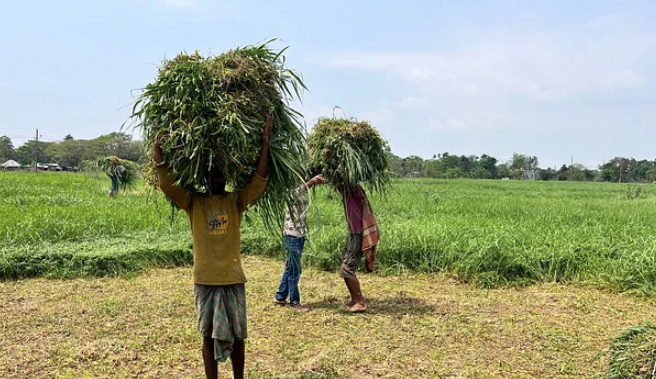Field after field of grassy gardens. One to three feet tall green grass will catch your eyes. From abandoned land to cultivable three-crop land, green grass is adorning it. The scene is from Karnaphuli Upazila of Chittagong. Grass is being cultivated in four of the five unions of the upazila. Raw grass is being sold as cattle feed both privately and commercially. The income is also high in grass cultivation at low cost.
Upazila livestock office sources said that there are 1 thousand 535 animal farms in Karnaphuli upazila. It has about 30,000 cattle. There is a huge demand for raw grass for these animals in the upazila. To meet the needs of these animals, grass is being cultivated on about 1200 acres of land in the upazila.
Alauddin, a farmer of Charlakshya Union of the upazila, said that the prices of gram, maize, husk, feed and hay are increasing day by day. Farmers are struggling to raise livestock. So the farmers of the upazila are becoming interested in farming by reducing the amount of cattle fodder. Many farmers can buy these grasses at low prices. The cost is decreasing. Cattle are also able to eat more food.
Some grass farmers said that 90 percent of farmers in the upazila cultivate German grass because most of the land is waterlogged and the production is high. Apart from this, others cultivate Napier Pakchong grass. Napier Pakchong grass is very nutritious. However, growers are turning to German grass for profit. The price of German grass per kg is five to seven rupees. A cow needs 20-28 kg of grass daily.
On the surface, it can be seen that grass has been cultivated in Shikolbaha, Charlakshya, Char Patharghata and Juldha Union of the upazila, in the fallow land, house yards, pond banks and even on both sides of the road. Apart from this, grass is being cultivated in some lands in Baruthan Union.
A farmer named Anshar Uddin said, ‘I cultivated grass on five acres of land. After taking the lease for 10 thousand taka per cane, the grass is sold for 70 thousand taka. Excluding expenses, the income is over 40 thousand rupees. One cultivation can cut grass six times. I meet the needs of my farm and sell outside. Many people are now cultivating grass because of low cost and high income.’
In this regard, Karnaphuli Upazila Livestock Officer Rumon Talukdar said that Karnaphuli Upazila is the second largest dairy zone in the country. The farmers of this upazila are cultivating grass to satisfy their needs and also selling it. Many are also making profit by selling grass. The main food of animals is grass. Nutritious grass contains a variety of nutrients including body-building nutrients. Local farmers are shifting their dependence on market beef to grass. It benefits both the farmer and the cultivator.
